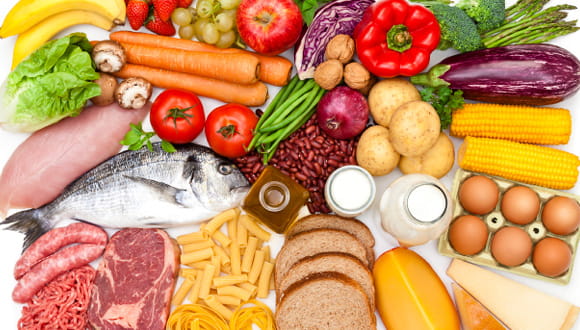When I was growing up, I remember gazing at the back of my cereal box while eating breakfast before school and seeing the food pyramid printed on the back. The base of the pyramid (the largest section) was covered with pixelated drawings of cereal, bread and a loaded plate of pasta. After a quick glance at my empty cereal bowl, and then back at the pyramid, I remember thinking, "Sweet! My favorite food is at the bottom!" If you think back to the 1990s and early 2000s, you may have a similar memory. Maybe you saw the pyramid on the back of a bag of bread or crackers — or perhaps on a poster in your school or doctor's office.
This begs the question: What happened to the food pyramid? Or, more importantly, is it still relevant?
Before we dig into this, let's make sure our memory of the food pyramid hasn't faded too much.
The United States Department of Agriculture (USDA) created the food pyramid in 1992. It placed grains at the base of the pyramid, with veggies and fruits on the next largest tier. These were the foods that were supposed to comprise most of our diets. The next tier was split, with dairy on the left and proteins on the right. The tip of the pyramid was reserved for fats and sweets, with a recommendation to eat these sparingly.
So what happened to the food pyramid?
The classic food pyramid was replaced in 2005 by a funky pyramid with a figure climbing up stairs on the side. If you don't remember this, don't worry — it wasn't around long.
In 2011, the new food pyramid was replaced by the USDA's MyPlate. This colorful plate is divided into four sections — one for fruit, veggies, protein and grains, and has a circle for dairy in the corner.
Every five years, the government updates the Dietary Guidelines for Americans — which includes a set of recommendations for healthful eating. Some years it looks pretty much the same, and other years it gets a makeover.
With new Dietary Guidelines coming in the next year or two, I'm curious if we will get a new and improved visual to replace the USDA's MyPlate and the bygone food pyramid. In the meantime, you can check out Canada's new, beautiful plate.
So is the food pyramid still relevant?
Short answer? No.
One thing you may notice is that fat is located at the very tip of the pyramid, lumped in the same category with sweets. This implies that all fats are unhealthy and that you should adopt a low-fat diet. You may remember that grocery store aisles used to be lined with 'low-fat' and 'fat-free' cookies and snacks, attempting to reel consumers in with the hope of choosing something healthy.
Nowadays, fat is making a comeback — because we know that some fats, like nuts, nut butters, avocadoes and extra virgin olive oil, have health benefits. Enter: avocado toast! New research has shown us that we can't put olive oil in the same category as soda.
Another thought that may pop into your head as you look at the old food pyramid is what some critics describe as the 'bread basket' at the base, which recommends 6-11 servings of grains per day. In this carb-phobic world, this may sound like a lot. Nowadays, the guidelines recommend about 6 ounces of grains for someone eating 2,000 calories per day.
Not only was the old food pyramid a little heavy on grains, it didn't make any specific recommendation to eat whole grains. Nutrient-rich whole grains (think oatmeal and quinoa) contain antioxidants, fiber and important vitamins. In addition, individuals who eat more whole grains enjoy a reduced risk of heart disease, type 2 diabetes and colorectal cancer.
So what should I follow?
While the USDA's new MyPlate has its flaws (i.e. the plate doesn't recommend healthy fats or focus on whole grains), I do like its simple message that half of your plate should be fruits and veggies.
The truth is that there isn't one diet that works best for everyone — but I think we can all benefit from eating more whole, nutrient rich foods that we enjoy. Take a look at your plate and add some color! I think my cereal bowl needed some color in my school days, and I'm not talking about Fruit Loops.


